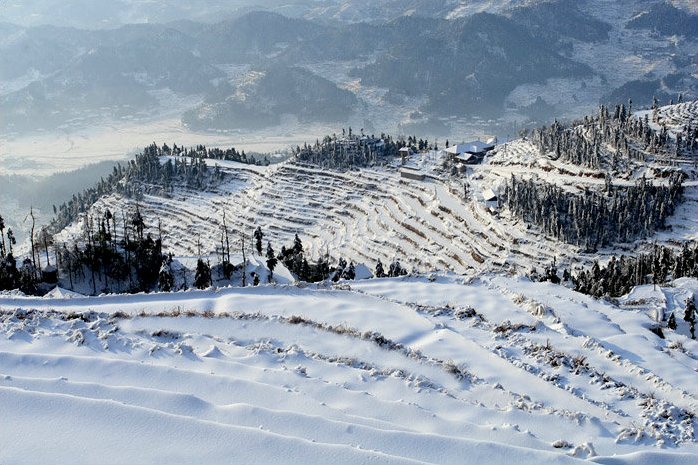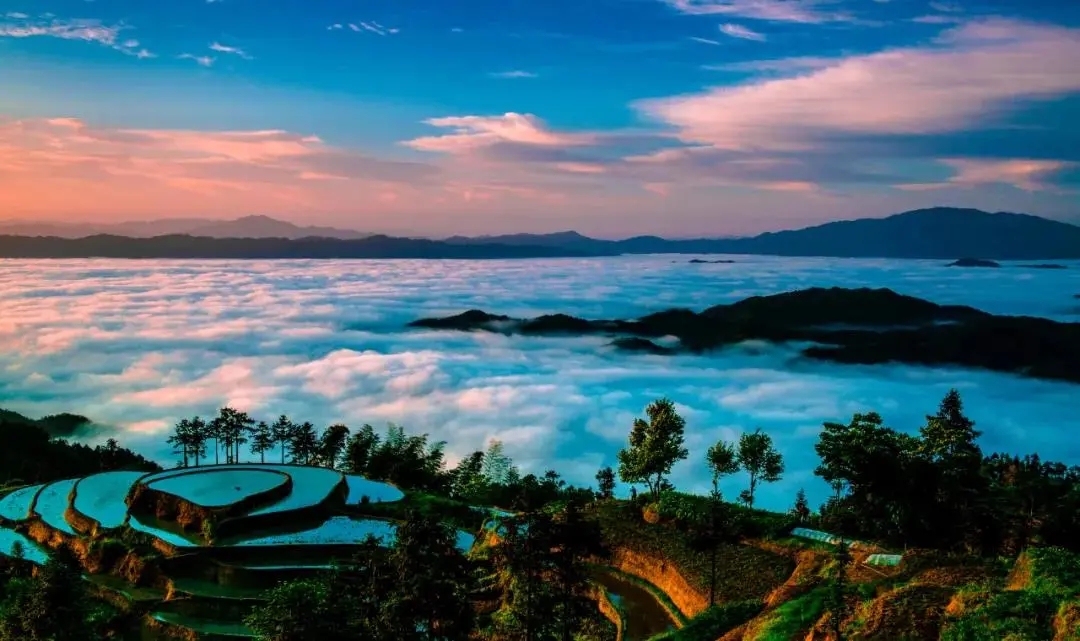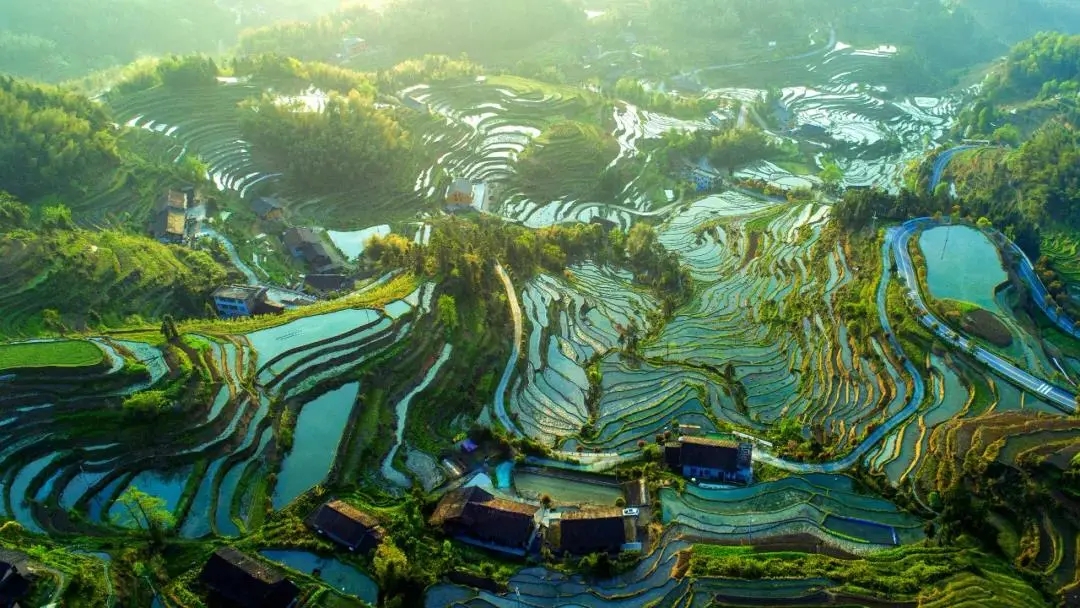Attractions
Longpu and Shifeng Terraced Fields
Longpu and Shifeng terraced fields are draped over steep or gentle, large or small hillsides, layer upon layer lying horizontally between heaven and earth. Thousands of acres of fields are connected in patches, and hundreds of terraced tiers are stacked one upon another. Rising and falling, they resemble a series of celestial ladders hanging down from the mountaintop all the way to the foot of the hill, displaying their vast and magnificent embrace with an awe-inspiring yet aloof aura. The landscape of Longpu terraced fields is divided into two parts. The terraced fields in Groups 1 and 8 in the eastern section, when viewed from the high mountains towards the south, reveal a breathtaking sight. The terraced fields are densely scattered across the mountain ridges, exuding a powerful and graceful charm, with curvilinear forms that are truly spectacular. Especially in the early morning, when sunlight bathes the fields, the contrast between surfaces and lines becomes more pronounced. Scattered among the fields and paths are wooden houses, with wisps of cooking smoke curling upwards and blending into the thin morning mist, creating a serene and dreamy atmosphere where the near is clear and the far is hazy. The Shuifeng Highway winds through these terraced fields, resembling a silver snake dancing among the mountains, a sight of indescribable beauty.

Snowy Scenery of Terraced Fields
When viewed from Linggong Temple downwards, Shifeng terraced fields present a different scene. The terraced fields wind around small hills, as if numerous stars are surrounding the moon. Continuing westward to Huangjiling and then looking back at Shifeng terraced fields, visitors are even more amazed by their shape and grandeur. The 300-acre tribute-grain terraced fields of Huangjiling, along with Laozhuang and Longxiang terraced fields, extend endlessly along the mountain slopes.

Sea of Clouds
Longpu and Shifeng terraced fields are bordered by the Xixi River to the south. For more than 60 days a year, one can witness vast seas of clouds formed by fog or after sudden rain showers. The clouds and mist flow between the green mountains and drift among the terraced fields, creating an ethereal atmosphere akin to being in a fairyland. Watching the sunrise here is particularly remarkable, as the morning glow on the horizon and the white mist on the ground reflect each other, with colors that change rapidly and endlessly, a truly wondrous sight in the world.

Spring Abounds in Terraced Fields
Yaorenchong Observation Deck
The Ziquejie Qinren Terraced Fields originated in the pre-Qin period and flourished during the Song and Ming dynasties, boasting a history of over two thousand years. The Miao and Yao ethnic groups are the creators of this marvelous human achievement at Ziquejie, a great accomplishment jointly created by the ancestors of multiple ethnic groups and a cultural relic of rice-growing heritage. It fully showcases the rice-growing culture where humans and nature coexist harmoniously at Ziquejie. In his poem "Opening the Meishan Region," Han official Zhang Dun of the Song Dynasty wrote, "People are seen in wooden houses stretching far, fields cultivated by fire on barren land are abundant," which is a true portrayal of the development of mountain terraced fields by the Miao, Yao, and other ethnic groups in Xinhua at that time.
The landscape of Yaorenchong terraced fields is formed by two mountain ridges and a depression, creating an "U" shape. The western ridge extends from the foot of the mountain all the way to the top, with over 200 tiers. The terraced fields have slopes ranging from 25 to 50 degrees, yet there is no soil erosion. There are no ponds or reservoirs here, nor even a proper irrigation channel, let alone the need for artificial irrigation, which is truly astonishing! This place bears witness to the remarkable achievements of the Yao people in carving out the terraced fields. According to archaeological experts, historical sites such as Yaoren Depressions, Yaoren Caves, and Yaoren Homesteads left behind by the Yao people have been discovered here, hence the name Yaorenchong.

Mist-Enshrouded Terraced Fields
Changshi Terraced Fields
Changshi Terraced Fields are the most magnificent, with the richest layers and the most aesthetically pleasing forms in Ziquejie. Spanning across mountains and ridges, they overlap layer by layer. Each layer resembles a delicate ripple, and each tier is like a clear, scale-like wave. Viewed up close, the paths crisscross; looked at from above, the terraced fields are as orderly as ladders to the sky; gazed down upon, the water surfaces shimmer, and the ridges meander like ink-wash landscape paintings.
Baishui Terraced Fields
Baishui Terraced Fields follow the contours of the mountains, curving, concave or convex, large or small, long or short, bright or dark. Some resemble stacked crescents reaching towards the sky; others are like wild snakes racing across the mountains. The winding terrace ridges, with their rhythmic curves, seem to emerge from the brushstrokes of immortals, forming ever-changing arcs.
Jinlong Terraced Fields
Between Laishi Ao and Yaji Village, there are 12 consecutive mountain ridges, undulating and winding, on which thousands of acres of terraced fields have been carved. They resemble 12 golden dragons vying to leap towards the mountaintop. In the afternoon, when sidelighting falls on the water surfaces of the terraced fields, the bright and shaded sides clearly reveal the grandeur of the terraces. In the evening, as sunlight filters through the western sunset glow, countless beams of light pour down from the red clouds, merging with the terraced fields to create an unparalleled spectacle.
Ziquejie boasts a beautiful ecological environment, with dense terraced fields, primitive forms, crisscrossing paths, smooth lines, towering mountains, and long-flowing waters, interspersed with wooden houses. It fully showcases the natural beauty, rustic charm, physical beauty, and cultural beauty of the terraced fields. Especially with the changing seasons and climates, Ziquejie Terraced Fields become even more graceful and enchanting, akin to a fairyland on earth.
Yueyashan Observation Deck
The terraced fields at Yueyashan Observation Deck feature smooth and flowing lines, strong arc degrees, resembling small crescents in the sky, hence the name Yueyashan (Crescent Moon Mountain).
The surrounding terraced fields here are arranged in an orderly manner, with smooth lines and distinct layers, resembling contour lines, exhibiting a strong sense of physical beauty.
Jiulongpo Observation Deck
"The mountains are high, the waters are long, and the tiered terraced fields reach towards the clouds." Standing at Jiulongpo and viewing the towering terraced fields, one experiences the aesthetic pleasure of "seeing ridges as peaks from different angles, with varying near and far, high and low perspectives." From afar, nine mountain ridges emerge faintly, resembling nine divine dragons vying to leap towards the mountaintop. Each ridge is like a dragon soaring towards the sky. If you approach the terraced fields for a closer look, you can see a boulder in the center of the terraces, a masterpiece of nature's craftsmanship, definitely not man-made. This is said to be the left eye of the dragon, with the right eye located directly in front of the wooden house ahead, both being of identical size and perfectly symmetrical.
The surface soil at Yueyashan is sandy loam, which does not stick to the hands. It can be seen that this soil is like a water-absorbing sponge, with a porosity as high as 39-57%, capable of absorbing 0.2-0.4 tons of water per cubic meter.
Yajizhai Observation Deck
Yajizhai is divided into two parts: Yajizhai Observation Deck and Ziquejie Pavilion. Ziquejie Pavilion is located at the mountaintop with an altitude of 1,200 meters, while Yajizhai Observation Deck stands at an altitude of 1,080 meters. Gazing far into the distance, the four seasons beauty of Ziquejie Terraced Fields can be fully appreciated. In spring, the fields are filled with water, resembling strings of silver chains hanging down the mountainside; in summer, the young crops turn lush green, resembling rows of green waves surging towards the horizon; in autumn, the heavy rice ears resemble golden towers piled up to the clouds; in winter, the snow promises a bountiful year, resembling rings of white jade, with the mountains dancing like silver snakes. Watching the sunrise at dawn, holding a golden apple in hand; viewing the sea of clouds in spring and summer, as if ascending to a jade pavilion in the heavens.
The scattered wooden houses, resembling snails, are like Buddhist beads scattered among the ethereal mountains and waters; wisps of cooking smoke rise; faint sounds of chickens crowing and dogs barking, along with the tinkling of spring water, intertwine with the sounds of nature. This heavenly realm where humans and nature are in harmony is beyond the description of poetry and painting.
Bagua Chong Observation Deck
The terraced fields spread across the mountains, layer upon layer, with winding and orderly forms, resembling the lively and elegant arcs drawn by a landscape painter, or like earth sculptures filled with mystery and spirituality. They resemble a randomly unfolded Bagua (Eight Trigrams) diagram, hence the name Bagua Chong.
The most prominent features of Bagua Chong Terraced Fields are their delicacy, refinement, agility, elegance, and beauty! This is the most beautiful and representative spot in the scenic area. Speaking of the delicacy and refinement of Bagua Chong, there are folk sayings about "Coir Raincoat Fields" and "Bamboo Hat Fields." Why are they called so? There is a story behind it: Since the terraced fields in Ziquejie cover a vast area, with each household owning more than one acre of terraced fields on average, the number of field plots per household is particularly large. Legend has it that a farmer once dug fields here all day long. He clearly remembered having 28 plots, but after counting repeatedly, he only found 26. As dusk approached, he thought, "It's time to go back!" He picked up his bamboo hat and found a small terraced field covered underneath. Then he picked up his coir raincoat and discovered another field beneath it. Thus, the sayings of "Coir Raincoat Fields" and "Bamboo Hat Fields" came into being.
Laomadang Observation Deck
Laomadang is formed by two towering mountains standing side by side. The terraced fields here have steep and precipitous slopes, resembling a celestial horse flying down to the valley bottom, making a resounding impact.
Legend has it that during the Southern Song Dynasty, Ziquejie produced the valiant Flying General Feng Chaorui, who served as the Shaozhou Recruitment Envoy. He was ordered to lead his clan on a southern expedition and stationed his troops in Jiangdong. He achieved remarkable military feats and subdued the Thirty-Six Barbarian Caves. In one battle, he shed his blood on the battlefield and sacrificed his life heroically. His loyal steed, carrying the general's blood-stained armor, traveled for three days and nights before finally returning to its hometown, Ziquejie. Truly, an old horse knows the way! According to legend, this steed has since lived in seclusion in this valley, mourning its master with daily wails. This observation deck is named after this historical story.
The folk houses in Ziquejie Terraced Fields have always maintained the traditional stilted architectural style for thousands of years.
Each house is an independent courtyard with sufficient space for a vegetable garden, fruit trees, and Fengshui trees. The stilted wooden houses have two floors. The original inspiration for this architectural style is related to the presence of wild beasts in mountainous areas and the hot and humid climate in the south. The orientations of each wooden house vary because there is a custom here that when building a house, a Fengshui master must be consulted to ensure that it does not clash with the Five Elements and is compatible with the owner's birth date and time, in order to ensure the well-being of the family and the prosperity of livestock.
In addition, there are several conspicuous white squares embedded on the outer dry walls of each wooden house. Why is that? Firstly, it stems from the hospitality of the people in Ziquejie. Long ago, when electricity was not available and kerosene lamps were used, the white squares could reflect moonlight, letting people know that there were inhabitants here, facilitating passersby to ask for directions or lodging. Secondly, there is a saying that it wards off evil spirits. Thirdly, these squares are made of woven bamboo strips painted with lime, reducing the use of trees and achieving the purpose of saving materials and protecting forests.
Gongmiling Observation Deck
Gongmiling Terraced Fields are composed of 12 ridges, including Huangjiling, Shexingling, and Wohuling, with the terraced fields nestled among the ridges and gullies. According to the "Xinhua County Annals," these terraced fields are developed from granite weathering products, known as hemp-powder mud fields. Moreover, they are located on sunny slopes with relatively long sunshine hours, capable of growing high-quality fragrant rice that was once presented as a tribute to the imperial court, hence the name Gongmiling (Tribute Rice Ridge).

